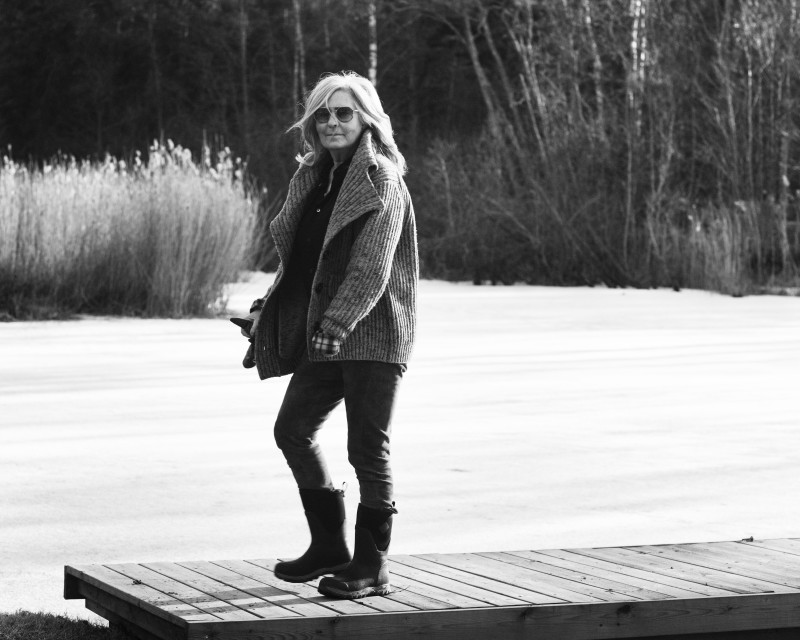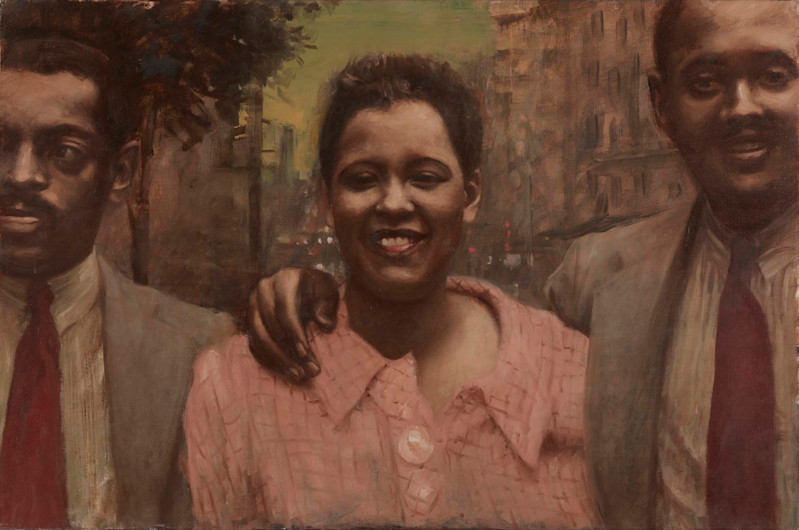She Reimagined Modern Fine-Art Photography Artist Denise Grünstein has passed away.
In Focus
June 25, 2023

Photo: Lisen Stibeck
Artist Denise Grünstein has passed away after a protracted battle with illness. 27 June would have been her 73rd birthday. Denise was born in Helsinki, to a family of avid art enthusiasts and readers. Perhaps it was the emphasis they placed on conversation, and the world of words in which she grew up that first led her to the path that eventually became her own: visual storytelling. Her stories embark from the point where words become inadequate, too limited to express such improbability, inexplicability, or beauty.
After studying in the USA and working in Stockholm, she began working for Svensk Filmindustri as a still photographer. This was where she refined her approach to telling stories through moods. She learned to communicate the entire essence of a film in a single picture. Her photographs from the award-winning _My Life as a Dog_ (Lasse Hallström, 1985) already reveal the incredible density and silence, brimming with significance, that would a become characteristic of her own later production. Becoming her own photographer, director, script writer and prop master, all in one.
However, Denise Grünstein didn’t just have a great sense of drama. When newspaper man Stefan Mehr took over as chief editor of the highly regarded arts magazine Månadsjournalen, the result wasn’t just a golden age for popular arts publications, but also, indirectly, a renaissance of intimate portrait photography. Denise Grünstein would be the one to set the standards – and she set them very high. Personalities like Queen Silvia of Sweden, poet Kristina Lugn, the aging cinema diva Anita Ekberg, and the much-loved entertainers Brasse Brännström and Magnus Härenstam were all immortalised in her pictures. These black-and-white portraits bring together the vibrant immediacy of the present and a timeless undercurrent of melancholy. However, Denise Grünstein was still regarded as a “mere" practitioner of the journalistic craft, albeit one who displayed an excellent sense of quality. In the 90s, the art world was still a male domain, and the hierarchies that divided genres remained firm and absolute.
One of Denise Grünstein’s earliest artistic victories was her participation in the ground-breaking exhibition Bländande bilder (“Dazzling Pictures”) in 1981. Leif Wigh, the first director of the photography department at Moderna Museet, curated an exhibition that left many in the profession awestruck. This was the first time a group of photographers (all female!) – Tuija Lindström was also among them – had proposed a new vision for the potential of photography. Here, the medium was presented as a space for imagination and dreams, an unrestricted playing field where the hyperreal, the mystical, the erotic, and the staged could all roam free. The exhibition sparked much debate, breaking as radically as it did with the (male) hierarchical view of photography as a conduit for cold, hard truth.
Many years later, in 2001, Wigh would organise Denise Grünstein’s first solo exhibition at Moderna Museet. By then, the photography collection had been integrated into the main collections, and the medium enjoyed the same status as other artistic techniques. This series of large format photographs marked the first major public appearance of Marta Oldenburg, the model who would remain Grünstein’s muse and collaborator for decades, and was featured in so many of her experimental explorations.
During the renovation of Nationalmuseum, the building was left empty for five years. During this time, Denise Grünstein was granted access to the galleries, which were built in 1866. There, she created 1866, a series of prints of Marta Oldenburg enacting the role as a kind of spirit of the museum. These suggestive, powerful pictures seem to decode and relay the history of the walls themselves. Unsurprisingly, the museum purchased the series, making Denise Grünstein the first living artist to be represented in the collections of both Moderna Museet and Nationalmuseum.
In 2018, Denise Grünstein had her first solo exhibition at CFHILL. This production represented a major undertaking for the gallery. All the walls had to be repainted, objects had to be cast, and an advanced video installation had to be installed. However, the greatest undertaking was without a doubt that of Denise, who – true to her habit – overcome all hindrances and limitations without hesitation. “Working with Denise was like living life on a theatre stage: everything was always in motion, following some cosmic orbit or other. She seemed to be guided by her intuition in her work, constantly questing for beauty,” says Michael Storåkers, Denise Grünstein’s gallerist at CFHILL.
She returned to the gallery a few years later for another major exhibition. This time, the pandemic had imposed new limitations on the scale of her projects, and Denise turned instead to an exploration of the drama she discovered on the bed of a lake. With Nymphaeas, a series of digital, “painted” photographs of waterlilies, she once again transformed the palatial gallery spaces of CFHILL into a universe entirely her own. The waterlilies also paid homage to another trailblazer who once wondered at these aquatic flowers: Claude Monet.
In recent times, the artist had been collaborating with CFHILL and Artipelag on a joint, dual retrospective. This project was to be realised as a pair of parallel exhibitions at both institutions, opening during the autumn of 2023. Now, these exhibitions will have to open without her. Despite our regret over this, we take pride and comfort in the fact that the project has been so richly informed by Denise Grünstein’s own ideas. We are determined to do justice to the intense joy she expressed in sharing her plans and visions to us.
“Denise Grünstein was a prominent pioneer of staged photography, who stood at the vanguard of the paradigm shift that occurred in fine-art photography during the 1990s. Grünstein’s artistic universe encompasses a diverse array of vantage points, oscillating between the domains of feminist identity politics and global political concerns,” says Bo Nilsson, director of Artipelag.
Denise Grünstein was, in all of her essence, a trailblazer. Her Jewish-Finnish, intellectual background, with all the implications it carried in terms of migration and upheavals, a legacy of trauma, and circumstances that required constant new beginnings, set her on the path that eventually saw her not merely reinventing an entire genre, but creating one of her own. Or, as a critic once wrote in a review of her pictures: “The camera doesn’t see, it dreams.” Denise Grünstein had plenty left to dream about, and the art world mourns her passing.



